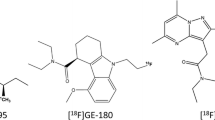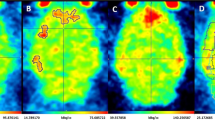Abstract
Purpose
The in vivo binding parameters of the novel imidazopyridine TSPO ligand [18F]PBR102 were assessed and compared with those of [18F]PBR111 in a rodent model of neuroinflammation. The validity of the key assumptions of the simplified reference tissue model (SRTM) for estimation of binding potential (BP) was determined, with validation against a two-tissue compartment model (2TC).
Methods
Acute neuroinflammation was assessed 7 days after unilateral stereotaxic administration of (R,S)-α-amino-3-hydroxy-5-methyl-4-isoxazolopropionique (AMPA) in anaesthetized adult Wistar rats. Anaesthetized rats were implanted with a femoral arterial cannula then injected with a low mass of [18F]PBR102 or [18F]PBR111 and dynamic images were acquired over 60 min using an INVEON PET/CT camera. Another population of rats underwent the same PET protocol after pretreatment with a presaturating mass of the same unlabelled tracer (1 mg/kg) to assess the validity of the reference region for SRTM analysis. Arterial blood was sampled during imaging, allowing pharmacokinetic determination of radiotracer concentrations. Plasma activity concentration–time curves were corrected for unchanged tracer based on metabolic characterization experiments in a separate cohort of Wistar rats. The stability of neuroinflammation in both imaging cohorts was assessed by [125I] CLINDE TSPO quantitative autoradiography, OX42/GFAP immunohistochemistry, Fluoro-Jade C histology, and elemental mapping using microparticle-induced x-ray emission spectroscopy. The BP of each ligand were assessed in the two cohorts of lesioned animals using both SRTM and a 2TC with arterial parent compound concentration, coupled with the results from the presaturation cohort for comparison and validation of the SRTM.
Results
The BPs of [18F]PBR102 [18F]PBR111 were equivalent, with improved signal-to-noise ratio and sensitivity compared with [11C]PK11195. The presaturation study showed differences in the volume of distribution between the ipsilateral striatum and the striatum contralateral to the injury (0.7) indicating that an assumption of the SRTM was not met. The modelling indicated that the BPs were consistent for both ligands. Between the SRTM and 2TC model, the BPs were highly correlated, but there was a bias in BP.
Conclusion
[18F]PBR102 and [18F]PBR111 have equivalent binding properties in vivo, displaying significantly greater BPs with lower signal-to-noise ratio than [11C]PK11195. While an assumption of the SRTM was not met, this modelling approach was validated against 2TC modelling for both ligands, facilitating future use in longitudinal PET imaging of neuroinflammation.







Similar content being viewed by others
References
Papadopoulos V, Amri H, Boujrad N, Cascio C, Culty M, Garnier M, et al. Peripheral benzodiazepine receptor in cholesterol transport and steroidogenesis. Steroids. 1997;62:21–8.
Morohaku K, Pelton SH, Daugherty DJ, Butler WR, Deng W, Selvaraj V. Translocator protein/peripheral benzodiazepine receptor is not required for steroid hormone biosynthesis. Endocrinology. 2014;155:89–97.
Vowinckel E, Reutens D, Becher B, Verge G, Evans A, Owens T, et al. PK11195 binding to the peripheral benzodiazepine receptor as a marker of microglia activation in multiple sclerosis and experimental autoimmune encephalomyelitis. J Neurosci Res. 1997;50:345–53.
Banati RB. Visualising microglial activation in vivo. Glia. 2002;40:206–17.
Banati RB, Newcombe J, Gunn RN, Cagnin A, Turkheimer F, Heppner F, et al. The peripheral benzodiazepine binding site in the brain in multiple sclerosis: quantitative in vivo imaging of microglia as a measure of disease activity. Brain J Neurol. 2000;123(Pt 11):2321–37.
Venneti S, Wiley CA, Kofler J. Imaging microglial activation during neuroinflammation and Alzheimer’s disease. J NeuroImmune Pharmacol. 2009;4:227–43.
Cremer JE, Hume SP, Cullen BM, Myers R, Manjil LG, Turton DR, et al. The distribution of radioactivity in brains of rats given [N-methyl-11C]PK 11195 in vivo after induction of a cortical ischaemic lesion. Int J Rad Appl Instrum B. 1992;19:159–66.
Petit-Taboue MC, Baron JC, Barre L, Travere JM, Speckel D, Camsonne R, et al. Brain kinetics and specific binding of [11C]PK 11195 to omega 3 sites in baboons: positron emission tomography study. Eur J Pharmacol. 1991;200:347–51.
Shah F, Hume SP, Pike VW, Ashworth S, McDermott J. Synthesis of the enantiomers of [N-methyl-11C]PK 11195 and comparison of their behaviours as radioligands for PK binding sites in rats. Nucl Med Biol. 1994;21:573–81.
Thominiaux C, Mattner F, Greguric I, Boutin H, Chauveau F, Kuhnast B, et al. Radiosynthesis of 2-[6-chloro-2-(4-iodophenyl)imidazo [1,2-a]pyridin-3-yl]-N-ethyl-N-[C-11]methyl-acetamide, [C-11]CLINME, a novel radioligand for imaging the peripheral benzodiazepine receptors with PET. J Labelled Comp Radiopharm. 2007;50:229–36.
Boutin H, Chauveau F, Thominiaux C, Kuhnast B, Gregoire MC, Jan S, et al. In vivo imaging of brain lesions with [C-11]CLINME, a new PET radioligand of peripheral benzodiazepine receptors. Glia. 2007;55:1459–68.
Van Camp N, Boisgard R, Kuhnast B, Theze B, Viel T, Gregoire MC, et al. In vivo imaging of neuroinflammation: a comparative study between [(18)F]PBR111, [(11)C]CLINME and [(11)C]PK11195 in an acute rodent model. Eur J Nucl Med Mol Imaging. 2010;37:962–72.
Mattner F, Bandin DL, Staykova M, Berghofer P, Gregoire MC, Ballantyne P, et al. Evaluation of [I-123]-CLINDE as a potent SPECT radiotracer to assess the degree of astroglia activation in cuprizone-induced neuroinflammation. Eur J Nucl Med Mol Imaging. 2011;38:1516–28.
Mattner F, Mardon K, Katsifis A. Pharmacological evaluation of [123I]-CLINDE: a radioiodinated imidazopyridine-3-acetamide for the study of peripheral benzodiazepine binding sites (PBBS). Eur J Nucl Med Mol Imaging. 2008;35:779–89.
Fookes CJ, Pham TQ, Mattner F, Greguric I, Loc’h C, Liu X, et al. Synthesis and biological evaluation of substituted [18F]imidazo[1,2-a]pyridines and [18F]pyrazolo[1,5-a]pyrimidines for the study of the peripheral benzodiazepine receptor using positron emission tomography. J Med Chem. 2008;51:3700–12.
Katsifis A, Loc’h C, Henderson D, Bourdier T, Pham T, Greguric I, et al. A rapid solid-phase extraction method for measurement of non-metabolised peripheral benzodiazepine receptor ligands, [F-18]PBR102 and [F-18]PBR111, in rat and primate plasma. Nucl Med Biol. 2011;38:137–48.
Dedeurwaerdere S, Callaghan PD, Pham T, Rahardjo GL, Amhaoul H, Berghofer P, et al. PET imaging of brain inflammation during early epileptogenesis in a rat model of temporal lobe epilepsy. EJNMMI Res. 2012;2:60. doi:10.1186/2191-219X-2-60.
Lammertsma AA, Hume SP. Simplified reference tissue model for PET receptor studies. Neuroimage. 1996;4:153–8.
Chauveau F, Boutin H, Van Camp N, Thominiaux C, Hantraye P, Rivron L, et al. In vivo imaging of neuroinflammation in the rodent brain with [11C]SSR180575, a novel indoleacetamide radioligand of the translocator protein (18 kDa). Eur J Nucl Med Mol Imaging. 2011;38:509–14.
Dickens AM, Vainio S, Marjamaki P, Johansson J, Lehtiniemi P, Rokka J, et al. Detection of microglial activation in an acute model of neuroinflammation using PET and radiotracers 11C-(R)-PK11195 and 18F-GE-180. J Nucl Med. 2014;55:466–72.
Bourdier T, Pham TQ, Henderson D, Jackson T, Lam P, Izard M, et al. Automated radiosynthesis of [18F]PBR111 and [18F]PBR102 using the Tracerlab FXFN and Tracerlab MXFDG module for imaging the peripheral benzodiazepine receptor with PET. Appl Radiat Isot. 2012;70:176–83.
Katsifis A, Mattner F, Dikic B, Papazian V. Synthesis of substituted [I-123]imidazo[1,2-alpha]pyridines as potential probes for the study of the peripheral benzodiazepine receptors using SPECT. Radiochim Acta. 2000;88:229–32.
Mattner F, Katsifis A, Staykova M, Ballantyne P, Willenborg DO. Evaluation of a radiolabelled peripheral benzodiazepine receptor ligand in the central nervous system inflammation of experimental autoimmune encephalomyelitis: a possible probe for imaging multiple sclerosis. Eur J Nucl Med Mol Imaging. 2005;32:557–63.
Paxinos G, Watson C. The rat brain in stereotaxic coordinates, 6th ed. New York: Academic; 2007.
Hunt GE, McGregor IS, Cornish JL, Callaghan PD. MDMA-induced c-Fos expression in oxytocin-containing neurons is blocked by pretreatment with the 5-HT-1A receptor antagonist WAY 100635. Brain Res Bull. 2011;86:65–73.
Schmued LC, Stowers CC, Scallet AC, Xu L. Fluoro-Jade C results in ultra high resolution and contrast labeling of degenerating neurons. Brain Res. 2005;1035:24–31.
Siegele R, Cohen DD, Dytlewski N. The ANSTO high energy heavy ion microprobe. Nucl Instrum Methods Phys Res B. 1999;158:31–8.
Ryan CG, Jamieson DN, Churms CL, Pilcher JV. A new method for online true-elemental imaging using Pixe and the proton microprobe. Nucl Instrum Methods Phys Res B. 1995;104:157–65.
Ryan CG. Developments in dynamic analysis for quantitative PIXE true elemental imaging. Nucl Instrum Methods Phys Res B. 2001;181:170–9.
Siegele R, Howell NR, Callaghan PD, Pastuovic Z. Investigation of elemental changes in brain tissues following excitotoxic injury. Nucl Instrum Methods Phys Res B. 2013;306:125–8.
Belloli S, Moresco RM, Matarrese M, Biella G, Sanvito F, Simonelli P, et al. Evaluation of three quinoline-carboxamide derivatives as potential radioligands for the in vivo PET imaging of neurodegeneration. Neurochem Int. 2004;44:433–40.
Boutin H, Chauveau F, Thominiaux C, Gregoire MC, James ML, Trebossen R, et al. 11C-DPA-713: a novel peripheral benzodiazepine receptor PET ligand for in vivo imaging of neuroinflammation. J Nucl Med. 2007;48:573–81.
Chauveau F, Van Camp N, Dolle F, Kuhnast B, Hinnen F, Damont A, et al. Comparative evaluation of the translocator protein radioligands 11C-DPA-713, 18F-DPA-714, and 11C-PK11195 in a rat model of acute neuroinflammation. J Nucl Med. 2009;50:468–76.
Arlicot N, Katsifis A, Garreau L, Mattner F, Vergote J, Duval S, et al. Evaluation of CLINDE as potent translocator protein (18 kDa) SPECT radiotracer reflecting the degree of neuroinflammation in a rat model of microglial activation. Eur J Nucl Med Mol Imaging. 2008;35:2203–11.
Arlicot N, Petit E, Katsifis A, Toutain J, Divoux D, Bodard S, et al. Detection and quantification of remote microglial activation in rodent models of focal ischaemia using the TSPO radioligand CLINDE. Eur J Nucl Med Mol Imaging. 2010;37:2371–80.
Ryu JK, Choi HB, McLarnon JG. Peripheral benzodiazepine receptor ligand PK11195 reduces microglial activation and neuronal death in quinolinic acid-injected rat striatum. Neurobiol Dis. 2005;20:550–61.
Moresco RM, Lavazza T, Belloli S, Lecchi M, Pezzola A, Todde S, et al. Quinolinic acid induced neurodegeneration in the striatum: a combined in vivo and in vitro analysis of receptor changes and microglia activation. Eur J Nucl Med Mol Imaging. 2008;35:704–15.
Martins E, Inamura K, Themner K, Malmqvist KG, Siesjo BK. Accumulation of calcium and loss of potassium in the hippocampus following transient cerebral ischemia: a proton microprobe study. J Cereb Blood Flow Metab. 1988;8:531–8.
Ong WY, Ren MQ, Makjanic J, Lim TM, Watt F. A nuclear microscopic study of elemental changes in the rat hippocampus after kainate-induced neuronal injury. J Neurochem. 1999;72:1574–9.
Peyronneau M, Loc’h C, Mattner F, Pham T, Jiang C, Pelegrini P, et al. In vitro metabolism of 18F PBR102 and 18F PBR111 in rats and humans. Eur J Nucl Med Mol Imaging. 2011;38:S231.
Conflicts of interest
None.
Author information
Authors and Affiliations
Corresponding author
Additional information
P.D. Callaghan and C.A. Wimberley contributed equally to this work as first authors.
Rights and permissions
About this article
Cite this article
Callaghan, P.D., Wimberley, C.A., Rahardjo, G.L. et al. Comparison of in vivo binding properties of the 18-kDa translocator protein (TSPO) ligands [18F]PBR102 and [18F]PBR111 in a model of excitotoxin-induced neuroinflammation. Eur J Nucl Med Mol Imaging 42, 138–151 (2015). https://doi.org/10.1007/s00259-014-2895-3
Received:
Accepted:
Published:
Issue Date:
DOI: https://doi.org/10.1007/s00259-014-2895-3




